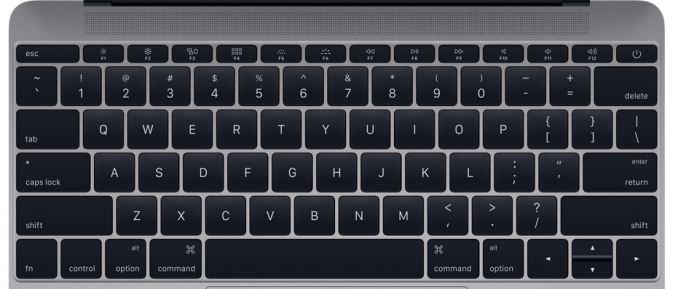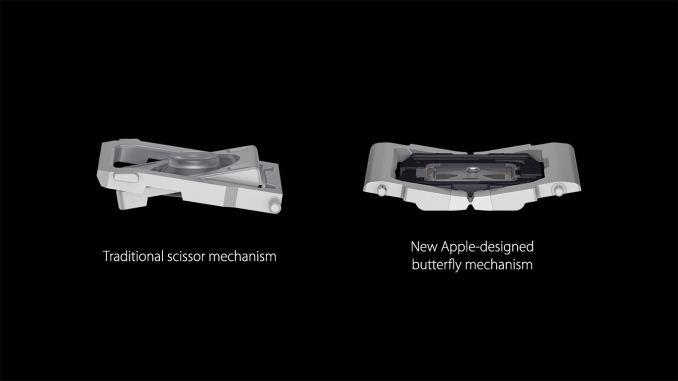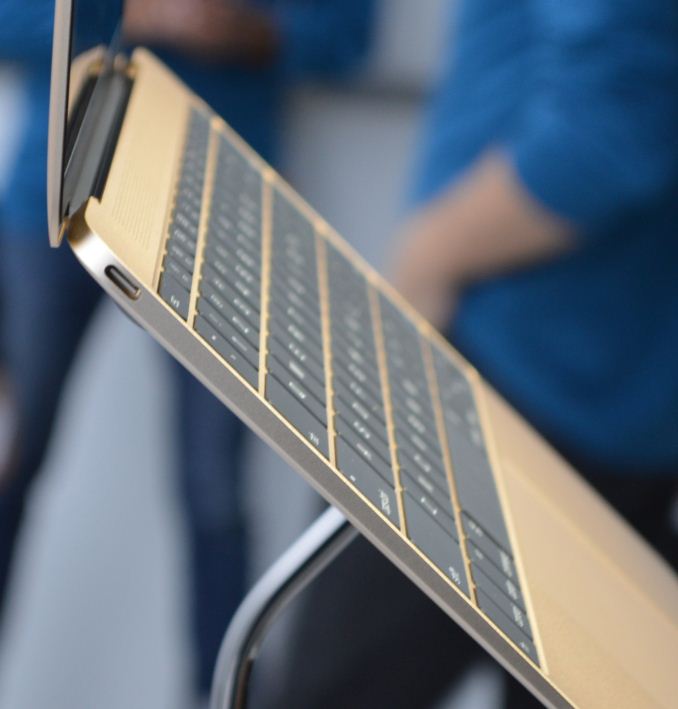The 2015 MacBook Review
by Ryan Smith on April 14, 2015 10:15 AM ESTGetting Thinner: New Keyboard, Keys, & Switches
One of the more interesting and not immediately obvious set of improvements to the MacBook come in the form of new internal mechanisms for the keyboard and trackpad. Though both look the same – and largely behave the same – as Apple’s existing products, under the hood they’ve been doing some work to improve these input devices. The driving factor of course is to further reduce the amount of Z-height these two devices take up, but there’s also a secondary focus on improving their functionality overall.
Starting with the keyboard, on the surface the MacBook implements a keyboard very similar to the now-traditional MacBook Air keyboard, incorporating a few smaller changes since their last design. Still a “full size” 78 key design that includes a top row of short function keys, Apple has made some changes to the keys themselves. Of note, the “inverted T” design of the arrow keys has been removed in favor of full size left and right arrow keys, giving the MacBook a somewhat odd arrangement where left/right are larger than up/down, rather than being identical in size as before. In Apple’s older design the space above left/right is empty space, so nothing is being sacrificed for this, but touch typists accustomed to the short arrow keys are going to have to do some adapting. Meanwhile at the other corner the escape key has been slightly elongated so that it’s wider than a normal key, and the other function keys have each been slightly narrowed to compensate.

Top: MacBook Keyboard. Bottom: MacBook Air Keyboard
Apple has also changed the overall size of the other keys, though even regular Mac users may have trouble picking up on this. The keys are now 17% larger, with Apple having slightly reduced the amount of space between each key to compensate. Meanwhile the keys are also have a deeper curve, which Apple tells us is 50% deeper. Truth be told, if not for the fact that Apple took the time to point this out in their reviewer’s guide I likely would not have picked up on either of these changes; the wider keys are noticeable once you know what to look for, but only just. Ultimately I don’t find the MacBook’s keyboard to be any different to type on as far as key size and feel goes (even with my large fingers), but your mileage may vary.

Backlit Keys: Minimal Edge Lighting
Meanwhile under the hood Apple has reworked the backlighting mechanism. The fiber optic lighting system that has been common in Apple’s designs until now has been replaced with a direct LED backlighting system, with each key having its own LED. Apple tells us that this was done for size reasons, as the direct backlighting system was smaller than the fiber optic lighting system. Not unexpectedly, this also changes how the overall backlighting system looks. The individual keys are as bright as ever – and Apple has gone so far to calibrate the LEDs to make sure they’re uniform – but with the LEDs now under the keys the amount of light around the edges of the keys has been greatly reduced. There is still some edge bleed, but now the lighting is much more focused on the symbols of the keys as opposed to lighting up the symbols and giving the keys a light border in the process.
Last but certainly not least however is the new key mechanism used underneath key, with like a number of other technologies is being first introduced on the MacBook. Apple has forgone the traditional scissor switch in favor of a newly designed mechanism they’re calling the butterfly switch, which in the slow-moving world of keyboards is the first significant change in quite some time.
The purpose of the butterfly switch is two-fold. The first of course is to reduce the size of the switch, allowing Apple to make the keyboard and resulting laptop thinner. Officially the butterfly switch is 40% thinner than Apple’s traditional scissor mechanism. That said, I’m not entirely convinced that Apple needed to switch mechanisms to reduce the keyboard thickness (though perhaps not getting 40% thinner), as we’ve seen other keyboards such as the Surface Pro 3’s type cover use some very thin scissor switches. Instead I suspect Apple’s change was focused on key stability as well.
Along with allowing for thinner keys, the other major improvement in the butterfly switch is key stability. By making the butterfly mechanism symmetrical Apple has done away with the scissor switch’s corner instability, which if pressed at a far corner would allow the scissor mechanism to actuate without actually triggering the switch. With the butterfly switch essentially composed of two identical halves that each prop up their respective corners, the instability has been eliminated as all four corners are similarly supported.
The end result, as Apple likes to pitch it, is that butterfly-backed keys are more stable and have the same feel to them no matter where on the key you press. And true to their word, in my experience this is exactly the case. The MacBook’s keys feel the same no matter where you press, and more importantly we haven’t encountered any failed keypresses in our formal or informal keyboard testing. Having used a number of scissor keyboards over the years, including a couple that suffered from non-registering corner keypresses, this is a welcome change as it’s seemingly impossible to have a key fail to register. That said the quality of scissor mechanisms definitely varies on a vendor-by-vendor basis, and with Apple’s scissor mechanism already performing well, I’m not sure if this is really all that big of a step up from other Apple designs. On the other hand what I’ve also found is that the instability problems of scissor keyboards seem to get worse as they get thinner, so it’s quite likely that Apple needed to make this change as they wouldn’t have been able to maintain their high keyboard quality with an even thinner scissor switch keyboard.
In any case, the other big change to keyboard feel is that due to the thinner switches, the total amount of key travel is significantly reduced. While the MBA and other Ultrabooks already had fairly low key travel, the MacBook’s keyboard reduces it yet again, and coupled with the changes in switches it makes the MacBook keyboard feel very different at times, and this is a difference that can take some getting used to at first. As thin as the switches are they’re closer to buttons than traveling keys – think iOS device home button – so typists accustomed to more travel and spring in their keys will immediately pick up on the difference, and I would wager take a temporary hit in words per minute (WPM) until they’ve fully adapted. After having used the MacBook for a week I can already type on it as well as I can my MacBook Pro, so it’s a relatively short adjustment period, but it’s there.
For a device of its size, overall I’d consider the MacBook’s keyboard to be an improvement over similar designs. That said, while I wouldn’t be surprised to see the backlighting improvements and key size changes eventually brought over to other MacBook designs, I don’t imagine we’ll be seeing the butterfly switch used on other, larger designs where Apple doesn’t need to be so conservative on space. As well as it works here, Apple doesn’t have the same need to deviate from the greater travel of scissor switches in their larger laptops.













354 Comments
View All Comments
tpoccu - Friday, April 17, 2015 - link
Did you write something similar about the original MacBook Air, you know the one that cost about 3 times as much as this, also had only USB, video out (micro-DVI if memory serves which nothing else ever used), and a headphone jack, and had atrocious performance compared to its contemporaries? The same MacBook Air that only one redesign later would go on to become the defacto standard for how mainstream laptops are built now. I suppose it is easier to rant without any use for foresight.Schickenipple - Monday, April 20, 2015 - link
Seriously, BittenRottenApple: You need to get laid.All companies will do whatever they can to sell whatever they can because they want to make money and people will continue to buy their stuff. If being 'informed' means that consumers will turn into you and start spouting useless crap on technology forums for hours at a time, then they would probably rather pay a lot of money for a new OS X device and have some fun. Even if it is just a sweet-looking netbook. Grow up and quit wasting your energy on this stuff.
Also: Change your username to something less troll-like and cliché. We all knew exactly how your comment would read before even reading it.
karpodiem - Monday, April 20, 2015 - link
I laughed through reading some of this, but agreed with much of it than I disagreed with.Spot on
star-affinity - Friday, April 24, 2015 - link
”They eliminate all ports except for one outdated USB port?”How is it outdated? USB 3.1 barely just hit the market.
”Other operating systems can be installed on just about any computer you can slap together, whereas OSX is specifically and deliberately designed to be non-functional on ANYTHING that isn’t made by apple.”
Not true – OS X works very well on my Hackintosh with very few modifications.
I wouldn't get this MacBook, but the recently updated 13" MacBook Pro looks quite nice in my book. I think OS X is worth a lot. There's less hassle with it overall (compared to Windows) and I can work much more switfly using it (less actions/steps needed for most common tasks). I say this working at an IT department at an office where there's computers running both Windows and OS X.
You don't have to like Apple or their products, but I don't thinks your criticism (or should I say rant) is very balanced.
sunnohh - Saturday, April 25, 2015 - link
Computers last 2 years for most Apple users 3 tops. Source former Apple certified repair tech. 1300 isn't that much money. And as a dedicated PC gamer with a Titan rig 24 USB ports; gigs of ram and inches of monitor; this MacBook seems like a great little second machine. I prefer portability in a laptop to power and as a somewhat fancy individual there are literally zero times I would ever need a port on a laptop other than power, which with an 8 hr battery can be discretely done from home. Some people have grown up jobs and need shiny Apple products and Mercedes cars to fit in at work.I am an extremely informed PC builder yet I choose Apple products because they are astonishingly high performing elegant bits of jewelry/PC. Ever compare the hinges on a MacBook to a Lenovo or asus? Good Christ. Apple sound quality? 100% better then the next best PC or android bar none. And I've tried everything and seen every measurement not even close. Color quality check.
Sure it's a cult but it's reasonably priced for the quality, especially compared to a Benz. And the best part of Apple ownership is I can have Apple pie and windows and it's ok. Seriously it's fucking awesome.
vista980622 - Wednesday, May 20, 2015 - link
There are some valid points there, and as a semi-professional video editor + graphics designer, I definitely know I'm not its' target audience. The new MacBook is designed for people who use computer differently than we do, and I'm glad a lot of my friends and people around me love the tiny laptop that is beautiful and light.vista980622 - Wednesday, May 20, 2015 - link
And I do enjoy the XPS 13 :)farhanshaikh74 - Sunday, May 24, 2015 - link
I was die hard apple fan from so many years and used to propagate apple products to such an extent that I am called Late Steve Job's best marketing guy in my hospital!However over last three years as Apple has stopped producing simple MacBook pro which are upgradeable (like mid 2012 MacBook pro) with DVD drive, I am feeling their vision of "design should include how things work" philosophy is losing its sheen.
Now they are selling only MacBook Retina, no non-retina laptops!, No laptops with DVD drive!! No laptops with 8GB RAM with normal Hard disk Drive which is upgradeable!!!
They are forcing us to buy ONLY Retian, with a fixed Flash drive which is meagre 126Gb or 256 GB, and those which come with 500 GB are exorbitantly costly.
They are forcing us to use iCloud for storage, without realising that in many parts of the world accessibility to WiFi and iCloud.
I am serious restricted by fixed 256GB Flash drive on my late 2013 Retina MacBook pro as I bought this expensive laptop, but struggling for space and the Flashdrive is not upgradeable!!
From last one week I am seriously considering Apple products and going back to Windows.
The design team in Apple is ignorant to a large population, who loves apple products and have moderate budget, they are busy catering only to high end products at premium price.
If this continues, they will find very few people using iOS in future and Apple will die its own death.
This is serious, as a die hard fan of Apple like me is writing such a comment!
Stimpak_Addict - Tuesday, June 9, 2015 - link
Check out Thunderbolt 3. It seems like they made this form factor to accommodate it once it's finalized (and hopefully they'll include at least 2 Thunderbolt 3 ports with the next iteration).jdw1992 - Sunday, June 14, 2015 - link
I have to point out a serious area you lack on knowledge. You berate USB as being outdated compared to thunderbolt. If you were speaking of anything but USB C you would be correct. However, and I do not know why Apple did not point this out, USB C and thunderbolt are now one and the same. Intel announced that the standard known as Thunderbolt is now part of the USB C standard. In other words, Apple is the first to land the next generation of peripheral ports, the most versatile and fast one to date.